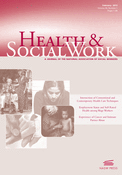-
Views
-
Cite
Cite
Heidi Allen, Moving Forward on the Medicaid Debate: Lessons from the Oregon Experiment, Health & Social Work, Volume 40, Issue 1, February 2015, Pages 3–9, https://doi.org/10.1093/hsw/hlu038
Close - Share Icon Share
Extract
In 2010, the Patient Protection and Affordable Care Act of 2010 (ACA) (P.L. 111-148) created fundamental changes to the Medicaid program. Historically, Medicaid served people who were poor (with the degree of poverty determined by each state) and who in addition fit into a special category, such as being pregnant, blind, or disabled. The ACA removed the categorical eligibility requirements that left many low-income adults uninsured, and the poverty threshold for eligibility was increased to a standardized 138 percent of the federal poverty level (FPL) (138 percent of FPL includes the 5 percent state discretionary income disregards). Although about half of states had operated some form of Medicaid expansion prior to the ACA, this element of the law was foundational to the overall goal of getting people insured. Medicaid expansions were slated to begin in January 2014, but an unanticipated 2012 decision by the U.S. Supreme Court (National Federation of Independent Business v. Sebelius, 2012) ruled the expansions optional and at the discretion of each state. This change in course reignited long-standing debate concerning the value of the program.





